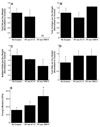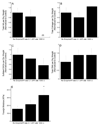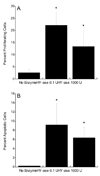Regulation of valvular interstitial cell phenotype and function by hyaluronic acid in 2-D and 3-D culture environments
- PMID: 20884350
- PMCID: PMC3021089
- DOI: 10.1016/j.matbio.2010.09.001
Regulation of valvular interstitial cell phenotype and function by hyaluronic acid in 2-D and 3-D culture environments
Abstract
Disruption of the extracellular matrix (ECM) is frequently found in calcific aortic valve disease (CAVD), yet the role of ECM components in valvular interstitial cell (VIC) function and dysfunction remains poorly understood. This study examines the contributions of exogenous and endogenous hyaluronic acid (HA), in both two-dimensional (2-D) and 3-D environments, in regulating the phenotype and calcification of VICs. VIC calcification was first assessed in a 2-D setting in which the cells were exposed to different molecular weights of exogenous HA presented in either an immobilized or soluble form. Delivery of HA suppressed nodule formation in a molecular weight-dependent manner, while blocking VIC recognition of HA via an antibody to CD44 abolished these nodule-suppressive effects and stimulated other hallmarks of valvular dysfunction. These 2-D results were then validated in a more physiologically-relevant setting, using an approach that allowed the characterization of VIC phenotype in response to HA alterations in the native 3-D environment. In this approach, leaflet organ cultures were analyzed following treatment with anti-CD44 or with hyaluronidase to specifically remove HA. Disruption of VIC-HA interactions upregulated markers of VIC disease and induced leaflet mineralization. Similarly, HA-deficient leaflets exhibited numerous hallmarks of CAVD, including increased VIC proliferation, apoptosis, increased expression of disease-related markers, and mineralization. These findings suggest that VIC-HA interactions are crucial in maintaining a healthy VIC phenotype. Identification ECM components that can regulate VIC phenotype and function has significant implications for understanding native valve disease, investigating possible treatments, and designing new biomaterials for valve tissue engineering.
Copyright © 2010 International Society of Matrix Biology. Published by Elsevier B.V. All rights reserved.
Figures











Similar articles
-
Manipulation of valve composition to elucidate the role of collagen in aortic valve calcification.BMC Cardiovasc Disord. 2014 Mar 1;14:29. doi: 10.1186/1471-2261-14-29. BMC Cardiovasc Disord. 2014. PMID: 24581344 Free PMC article.
-
Transforming growth factor-β1 promotes fibrosis but attenuates calcification of valvular tissue applied as a three-dimensional calcific aortic valve disease model.Am J Physiol Heart Circ Physiol. 2020 Nov 1;319(5):H1123-H1141. doi: 10.1152/ajpheart.00651.2019. Epub 2020 Sep 28. Am J Physiol Heart Circ Physiol. 2020. PMID: 32986963
-
Knockdown of CD44 expression decreases valve interstitial cell calcification in vitro.Am J Physiol Heart Circ Physiol. 2019 Jul 1;317(7):H26-H36. doi: 10.1152/ajpheart.00123.2018. Epub 2019 Apr 5. Am J Physiol Heart Circ Physiol. 2019. PMID: 30951363 Free PMC article.
-
Hydrogen sulfide inhibits aortic valve calcification in heart via regulating RUNX2 by NF-κB, a link between inflammation and mineralization.J Adv Res. 2020 Jul 21;27:165-176. doi: 10.1016/j.jare.2020.07.005. eCollection 2021 Jan. J Adv Res. 2020. PMID: 33318875 Free PMC article. Review.
-
Uncoupling the Vicious Cycle of Mechanical Stress and Inflammation in Calcific Aortic Valve Disease.Front Cardiovasc Med. 2022 Mar 9;9:783543. doi: 10.3389/fcvm.2022.783543. eCollection 2022. Front Cardiovasc Med. 2022. PMID: 35355968 Free PMC article. Review.
Cited by
-
Valve endothelial-interstitial interactions drive emergent complex calcific lesion formation in vitro.Biomaterials. 2021 Feb;269:120669. doi: 10.1016/j.biomaterials.2021.120669. Epub 2021 Jan 8. Biomaterials. 2021. PMID: 33482604 Free PMC article.
-
Multilayer three-dimensional filter paper constructs for the culture and analysis of aortic valvular interstitial cells.Acta Biomater. 2015 Feb;13:199-206. doi: 10.1016/j.actbio.2014.11.039. Epub 2014 Nov 25. Acta Biomater. 2015. PMID: 25463506 Free PMC article.
-
Hyaluronan turnover and hypoxic brown adipocytic differentiation are co-localized with ossification in calcified human aortic valves.Pathol Res Pract. 2012 Nov 15;208(11):642-50. doi: 10.1016/j.prp.2012.08.001. Epub 2012 Sep 25. Pathol Res Pract. 2012. PMID: 23017666 Free PMC article.
-
Manipulation of valve composition to elucidate the role of collagen in aortic valve calcification.BMC Cardiovasc Disord. 2014 Mar 1;14:29. doi: 10.1186/1471-2261-14-29. BMC Cardiovasc Disord. 2014. PMID: 24581344 Free PMC article.
-
Developmental lineage of human pluripotent stem cell-derived cardiac fibroblasts affects their functional phenotype.FASEB J. 2021 Sep;35(9):e21799. doi: 10.1096/fj.202100523R. FASEB J. 2021. PMID: 34339055 Free PMC article.
References
-
- Aikawa E, Whittaker P, Farber M, Mendelson K, Padera RF, Aikawa M, Schoen FJ. Human semilunar cardiac valve remodeling by activated cells from fetus to adult: implications for postnatal adaptation, pathology, and tissue engineering. Circulation. 2006;113:1344–1352. - PubMed
-
- Allison DD, Braun KR, Wight TN, Grande-Allen KJ. Differential effects of exogenous and endogenous hyaluronan on contraction and strength of collagen gels. Acta. Biomater. 2009;5:1019–1026. - PubMed
-
- Barbosa I, Garcia S, Barbier-Chassefiere V, Caruelle JP, Martelly I, Papy-Garcia D. Improved and simple micro assay for sulfated glycosaminoglycans quantification in biological extracts and its use in skin and muscle tissue studies. Glycobiology. 2003;13:647–653. - PubMed
-
- Chao H, Spicer AP. Natural antisense mRNAs to hyaluronan synthase 2 inhibit hyaluronan biosynthesis and cell proliferation. J. Biol. Chem. 2005;280:27513–27522. - PubMed
Publication types
MeSH terms
Substances
Grants and funding
LinkOut - more resources
Full Text Sources
Miscellaneous

